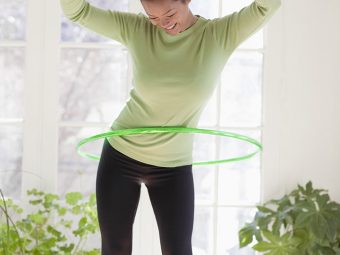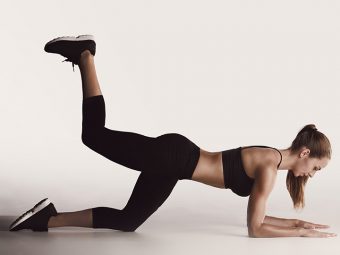13 Health Benefits Of Swimming And Exercises For Fitness
Enhance your flexibility and strength, all while having fun and meeting your fitness goals.

Image: Shutterstock
The benefits of swimming exercises may entice you to put on your swimsuit and take a dip. Swimming is a great alternative to sweating in the gym and one of the most beneficial aerobic exercises (1). Health experts encourage swimming exercises as they are suitable for anyone, regardless of age and ability. It has social benefits too! You can go swimming with family or friends to make it a fun and enjoyable exercise.
A UK-based study was conducted to understand outdoor swimming patterns and their relative impact on overall health. Of a total of 722 outdoor swimmers, 498 (68.9%) were female. The results concluded that outdoor swimming has a positive high impact on health across all wellness categories: It was 3.57 times higher in general, while 44.32 times higher for mental health, and 5.25 times higher for those with injuries.
Check out these tips for new swimmers, the benefits of swimming, and guidelines to stay safe while swimming. Scroll down.
 Swimming Exercises
Swimming Exercises- Frequency: 2–3 times per week
- Benefits: Aid in weight loss, strengthen the bones, and improve heart health.
- Equipment Needed: Swimming suit, goggles, swimming cap.
- Space Required: Large area
- Assistance Required: Yes, for certain exercises
- Who Should Avoid: People with an open wound, infection, or chlorine sensitivity.
In This Article
13 Benefits Of Swimming

1. Aids Weight Loss
Swimming is a great way to burn calories. And the more calories you burn, the more fat gets mobilized leading to weight loss and management. As a result, you will start losing the extra flab in your body. Korean scientists conducted an experiment on obese children and found that swimming and other aquatic exercises helped reduce fat mass in their body (2).
2. Builds Bone Strength
Bone mass decreases with age, especially in women. Swimming can help prevent bone loss triggered by age and other forms of aerobic exercises. It is also helpful for those with joint pain or arthritis. Scientists conducted an experiment and found that swimming ameliorates osteoporosisi XA bone disease characterized by weak and brittle bones, which increases the risk of sudden fractures. , helps improve bone mass, and strengthens the bones (3), (4).
3. Improves Heart Health
The number of people suffering from heart diseases has skyrocketed in the recent past. So, if you lead a sedentary lifestyle and feel that going to the gym is dreadful, try having fun in the cool blue water. Water aerobics will help improve your heart health and protect you from potential cardiovascular diseasesi XA group of diseases that affect the blood vessels and heart due to genetics or the build-up of fatty deposits inside the arteries. and leads to a reduced risk of chronic diseases. It can also improve muscle strength and tone. In fact, various studies have found that swimming is one of the best exercises for keeping your heart in good condition and may even aid improved circulation (5).
4. Helps Children With Cerebral Palsy
Cerebral palsy is a common movement disability in children, and it affects about 4 in 1000 newborns or children of different age groups (6). Exercising can help children with cerebral palsy to improve their motor functions. However, the fun element of exercise also has to work to provide the children with a positive experience. Australian scientists have found that swimming is enjoyed by children with cerebral palsy, and they also did not feel fatigued by it (7).
5. Improves Flexibility
Flexibility is the ability to move your joints to their full range. When you swim, you use your limbs and core to propel your body forward and stay afloat. Swimming every day helps improve whole body flexibility and range of motion and, as a result, reduces joint pain (5).
6. Improves Body Coordination
It’s a no-brainer that swimming requires a lot of coordination between the legs, arms, head, chest, and eyes. Be it for recreational, therapeutic, or competition purposes, swimming regularly leads to improved balance and coordination between the limbs and the core (8).
7. Lowers Triglyceride In Elderly
The higher the triglyceride levels, the more the risk of heart disease and early death. Scientists conducted an experiment on middle-aged women. They found that women who swam 60 minutes a day for 3 weeks had a better body composition, lost weight, and improved their blood lipid profilesi XA medical examination used to measure cholesterol and triglyceride levels to determine one’s cardiac health. . They also recorded a drop in their blood triglyceride levels (9).
8. May Increase Neurogenesis
Temporal lobe epilepsy is a neurological disease, which is caused by brain cell death. In most cases, antiseizure drugs do not work. In an effort to find alternative treatments, a research study led by Prof. Vasavi R. Gorantla has found that swimming increases neurogenesisi XA process where new neurons or nerve cells are created mostly during prenatal development and some during an individual’s lifespan. in laboratory rats (10).
9. Improves Asthma
Asthma is caused due to inflammation in the airways, which blocks them and leads to difficulty in breathing. Various studies have found that swimming can help reduce asthma attacks. It is also more beneficial than land exercises (11). Swimming is also said to aid improved lung capacity.
10. Improves Sleep Quality
If you have difficulty in sleeping, you must start swimming. Swimming is a full-body aerobic exercise, and if have ever spent some time in the water, you know how exhausting it can be. That’s because your entire body, along with your brain, works constantly while swimming. This is precisely what leads to improved sleep quality (12).
11. Supports Mental Health
Stress, anxiety, and depression are mental health issues that you should never ignore. Scientists have found that swim therapy can help in stress reduction, uplift mood and treat various serious psychological issues (13), (14).
12. Slows Down Aging
Literally going back in time may not be possible, but swimming can help you look younger. And that’s because it helps uplift your mood which, in turn, lowers oxidative stressi XAn imbalance of antioxidants and free radicals in the body, which increases the risk of heart diseases. in the body. As a result, your body functions normally without slowing down (15).
13. Tones And Strengthens Muscles
You already know that swimming aids fat loss. But it also helps tone and strengthen your muscles which results in improved posture. The repeated movement of your legs, hands, chest, head, abs, and neck against water resistance helps you build slender muscles instead of bulky ones. Plus, your muscles’ strength and power also increase as you practice swimming, which requires you to push your body forward by constantly displacing the water surrounding you. For tendon, ligament, or muscle issues, your doctor may recommend swimming for injury rehabilitation.
Marni Sumbal, author, certified sports dietitian and blogger, recalls her personal experience of how swimming has worked wonders for her physical, mental, as well as overall health. She shared how she developed an inclination towards swimming from a very young age and the passion continues. She finds swimming to be an energetic workout medium and adds, “I love the way my body feels when it is non-weight bearing and the fact that I can get a great cardio and muscular workout in the water…And swimming is the best sport ever! :) (i).”
These are the 13 best benefits of swimming. Did you know that there are various types of swimming strokes? Well, here’s a list of swimming strokes that can help you.
10 Swimming Exercises
1. Freestyle
- This is one of the fast strokes and is best for beginners.
- Float on the water with your face down, and hands extended above your head on the surface of the water.
- Take your right hand under the water, push the water back, lift your right hand above the water, and bring it back to the starting position.
- Quickly, take your left hand under the water and do the same. Make sure to move your head side to side to inhale and exhale.
2. Backstroke
- Float on the water on your back. Your hands must be by your side.
- Lift your right hand, move it in a circle, and plunge it back in the water.
- Push the water back so that your body moves forward.
- Recover your right hand to the surface.
- Simultaneously, do the same with your left hand.
3. Breaststroke
- Float in the water with your face down, body flat, and arms extended over your head.
- Keep your arms straight and pull water from above your head to your chest.
- As your palms reach your chest level, fold your arms back and move both of them over your head to the starting position.
- Extend your arms forward, submerge your head in the water, and exhale slowly through your mouth or nose.
- Kick the water backward to help you move forward.
4. Butterfly
- Float in the water with your face down, arms extended above your head, and palms facing down.
- Pull your arms down and move your hands in a semicircular motion towards your body.
- Recover both your arms in a sweeping motion out of the water.
- Let your hands re-enter the water and come back to the starting position.
- As your arms just come out of the water, lift your chin, look straight, and breathe in.
- Your leg action should be like that of a mermaid. Keep both your legs together, and toes pointed out, and kick downward.
- The second kick should be more powerful to help you move forward when your arms are in the recovery phase.
5. Dog Paddle
- Float in the water with your head up.
- Paddle your hands and legs in an alternative manner imitating how dogs swim.
6. Sidestroke
- Float on your right. Keep your right arm extended, and legs together. Tilt your head up and look sideways.
- Perform the scissor action with your legs. Flex both your legs and move the top leg forward and bottom leg backward and bring them back to the starting position in a circular motion.
- Use your right arm to pull the water from above your head. Your top arm is the trailing arm that helps push the pulled water downward.
So, these are the most popular swimming strokes. Now, here are some tips for you – if you are a beginner.
Swimming Tips For Beginners
Take a look at a few swimming tips and tricks that might help you improve your style of swimming and make you a better swimmer:
- Put your swim goggles on an hour before you get into the pool so that you get accustomed to them. Keep an additional pair of goggles handy. One clear set for cloudy, foggy days, and another dark set for bright sunny days.
- Practice and focus on pulling straight back as you take a breath or roll your shoulder.
- Go in for a pair of swimming fins to help in efficiently kicking without crossing one foot over another.
- Swim fins also help increase the flexibility of your ankles.
- Use a swimmer’s snorkel to help you focus on body rotation and arm strokes with ease.
- Use silicon ear plugs to prevent ear infection and limit irritation.
- Keep a small towel handy for drying, cleaning or wiping purposes.
- Interact with experienced swimmers for guidance and tips.
 Quick Tip
Quick TipWhile swimming offers many advantages, there also are a few risks associated with it. Learn more in the next section.
Disadvantages Of Swimming
Some disadvantages associated with swimming include (16):
- Risk Of Drowning: Although swimming is a valuable life skill, there is always a risk of drowning, especially in unsupervised or unsafe environments.
- Skin Issues: Chlorine and other pool chemicals may lead to skin dryness, irritation, and hair damage and result in swimmer’s itch or skin rashes.
- Respiratory Issues: The chlorine fumes in indoor pools may exacerbate asthma symptoms in some individuals and cause respiratory irritation.
- Hygiene Concerns: Public pools may lack proper hygiene and raise infection risk.
You can overcome these downsides by keeping in mind some general swimming tips that will help you be a good swimmer.
A Few General Swimming Tips
- It is recommended to select a safe environment, with lifeguards on duty, for swimming.
- Always remember to do warm-up exercises and stretch your joints and muscles before you enter the water.
- Have plenty of fluids handy and always keep your body well hydrated.
- If you are just a beginner, do not overdo swimming.
- See your doctor before you begin swimming if you have a sedentary lifestyle and have not done any exercise in a long time.
 Quick Tip
Quick TipAlthough swimming is a low-impact exercise, swimming injuries may occur due to incorrect technique or over demanding workouts. Some of these are:
- Swimmer’s shoulder
- Breaststroke knee
- Neck injuries
- Lower back injuries
These injuries can be prevented by following these simple rules.
Prevention Of Swimming Injuries

- Always remember to do warm up and stretch before a swimming session.
- After a swimming session, remember to cool down and stretch.
- Develop your functional strength by following a general program.
Infographic: 6 Ways Swimming Can Improve Your Mental Health
Swimming is one of the most recommended activities for anyone looking to lose weight and improve their overall physical fitness. But did you know that this fun water exercise is beneficial for the mind too? Scroll down and check out the infographic below to learn how swimming can improve your mental health.

Illustration: StyleCraze Design Team
The benefits of swimming exercises are so undeniable that you cannot afford to miss out on them if you want a toned, flexible, and fit body. Swimming is the best way to burn calories and fat, improve heart and bone health, enhance motor function in children with cerebral palsy, improve body composition, reduce triglyceridei XA type of converted fat found in the blood and used by the body to give energy between meals. levels in the blood, uplift mood and mental health, promote sleep, and achieve improved overall health and well-being. However, faulty technique while doing these exercises can result in injuries to the shoulders, neck, lower back, and neck. Also, do not forget to do warm-up exercises before starting pool exercises.
Frequently Asked Questions
Is swimming good for losing belly fat?
Yes. Swimming is a full-body workout and can help you lose belly fat over time.
What happens if I swim daily?
Daily swim workouts may help boost your overall health by building strength and endurance.
Does swimming change body shape?
Yes. Swimming helps you achieve a toned and fit body with broad shoulders.
Is swimming better than gymming?
It depends on your fitness goal. For example, swimming is better if you want to build cardiovascular fitness and for endurance training, while gymming is more suitable for building muscles.
Key Takeaways
- Swimming is great for burning calories and fat, enhancing body composition, and boosting heart and bone health.
- It can also promote motor function in children with cerebral palsy, help with lower triglyceride levels in the blood, uplift your mood and mental health, and improve sleep.
- There are different swimming styles you can opt from, like freestyle, breaststroke, backstroke, and butterfly, as each targets specific areas of the body.
- Incorrectly performing swimming exercises may result in injuries to your shoulders, lower back, and neck

Image: Stable Diffusion/StyleCraze Design Team
Dive into the world of swimming and uncover 16 astonishing benefits that go beyond the surface. From total-body workout to stress relief, this video uncovers the hidden gems of swimming. Get ready to make a splash!
Personal Experience: Source
StyleCraze's articles are interwoven with authentic personal narratives that provide depth and resonance to our content. Below are the sources of the personal accounts referenced in this article.
i. Maintaining motivation to train – swimminghttps://trimarni.blogspot.com/2016/02/maintaining-motivation-to-train-swimming.html
References
Articles on StyleCraze are backed by verified information from peer-reviewed and academic research papers, reputed organizations, research institutions, and medical associations to ensure accuracy and relevance. Read our editorial policy to learn more.
- A Harvard doctor says these are the best exercises for your body
https://www.independent.co.uk/life-style/best-exercises-body-weight-loss-muscle-building-harvard-doctor-a8001401.html - The effects of aquatic exercise on body composition physical fitness and vascular compliance of obese elementary students
https://www.ncbi.nlm.nih.gov/pmc/articles/PMC4106774/ - Swimming Activity Prevents the Unloading Induced Loss of Bone Mass Architecture and Strength in Rats
https://www.ncbi.nlm.nih.gov/pmc/articles/PMC4450217/ - The osteogenic effects of swimming on bone mass strength and microarchitecture in rats with unloading-induced bone loss
https://pubmed.ncbi.nlm.nih.gov/26179081/ - The health & wellbeing benefits of swimming
https://static1.1.sqspcdn.com/static/f/814454/27601933/1498121671990/Health+and+wellbeing+benefits+of+swimming+report+2.pdf?token=RBihHdelrujQ%2BNK7EqgP01CdM54%3D - 11 Things to Know about Cerebral Palsy
https://www.cdc.gov/ncbddd/cp/features/cerebral-palsy-11-things.html - Benefits and Enjoyment of a Swimming Intervention for Youth With Cerebral Palsy: An RCT Study
https://pubmed.ncbi.nlm.nih.gov/26871379/ - Effects of swimming on eye hand coordination and balance in the elderly
https://pubmed.ncbi.nlm.nih.gov/20922347/ - Effect of regular swimming exercise on the physical composition strength and blood lipid of middle-aged women
https://www.ncbi.nlm.nih.gov/pmc/articles/PMC4625655/ - Effects of Swimming Exercise on Limbic and Motor Cortex Neurogenesis in the Kainate-Lesion Model of Temporal Lobe Epilepsy
https://www.ncbi.nlm.nih.gov/pmc/articles/PMC4893441/ - Swimming and asthma. Benefits and deleterious effects
https://pubmed.ncbi.nlm.nih.gov/1470792/ - Aerobic exercise improves self-reported sleep and quality of life in older adults with insomnia
https://www.ncbi.nlm.nih.gov/pmc/articles/PMC2992829/ - Mood alteration with swimming–swimmers really do ”feel better”
https://pubmed.ncbi.nlm.nih.gov/6635105/ - Exercise for Mental Health
https://www.ncbi.nlm.nih.gov/pmc/articles/PMC1470658/ - The Free Radical Theory of Aging Is Dead. Long Live the Damage Theory!
https://www.ncbi.nlm.nih.gov/pmc/articles/PMC3901353/ - Medical Care for Swimmers
https://www.ncbi.nlm.nih.gov/pmc/articles/PMC4960281/


































